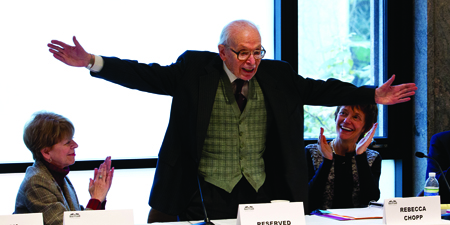Single Largest Gift—$50 Million—Comes To The College

Gene Lang ‘38 announces his gift of $50 million at the Board of Managers meeting, with daughter Jane ’67, left, and President Rebecca Chopp to his right. Photo by Laurence Kesterson
At the height of the holidays, Swarthmore College received an imaginative and historic gift, bestowed in all the joyful spirit of the season: $50 million from Eugene Lang ’38.
The Board of Managers gathered for its Dec. 8 morning meeting in the Scheuer Room unaware that there would be a historic announcement. Board Chair Gil Kemp ’72 opened the meeting with a customary moment of silence, then invited President Rebecca Chopp to speak.
She turned to the man sitting to her right, tracing the ways in which the College and its greatest benefactor had grown together since he arrived on campus in 1934 as a teenager from New York City. She described how the man and the College had blossomed powerfully and symbiotically during the following 80 years.
Due to Lang’s creativity, entrepreneurial vision, and generosity, the campus has experienced “a burgeoning of all of the arts here,” Chopp noted. Concrete examples are the Eugene M. and Theresa Lang Performing Arts Center, including its List Gallery, as well as the Lang Music Building. He also has fostered engagement with the wider world by establishing the Lang Opportunity Scholars program and the Eugene M. Lang Center for Civic and Social Responsibility.
Now, Lang’s $50 million gift will spark a flowering of disciplines, especially engineering and science, through construction of new facilities, and support facets of the strategic plan.
“This is truly an inspirational gift from an inspirational person that will be transformative on our campus,” Chopp said, smiling broadly.
Lang then spoke, revealing that his “relationship to Swarthmore has been an incredibly fulfilling experience—especially the opportunity to get to know you [President Chopp].”
He added, “There is no greater satisfaction than the opportunity to talk to Swarthmore students.” Lang also thanked President Chopp for her “inspiration of the idea” for the gift.
Chopp later summed up the gift: “As with all of Gene’s gifts, it will help us think boldly—about the intersectionality of engineering and other disciplines; it will make possible new and renovated facilities and spaces for many academic departments; and it will help us continue to expand our influence in the world through the creative scholarship of our students and faculty.”
 Email This Page
Email This Page